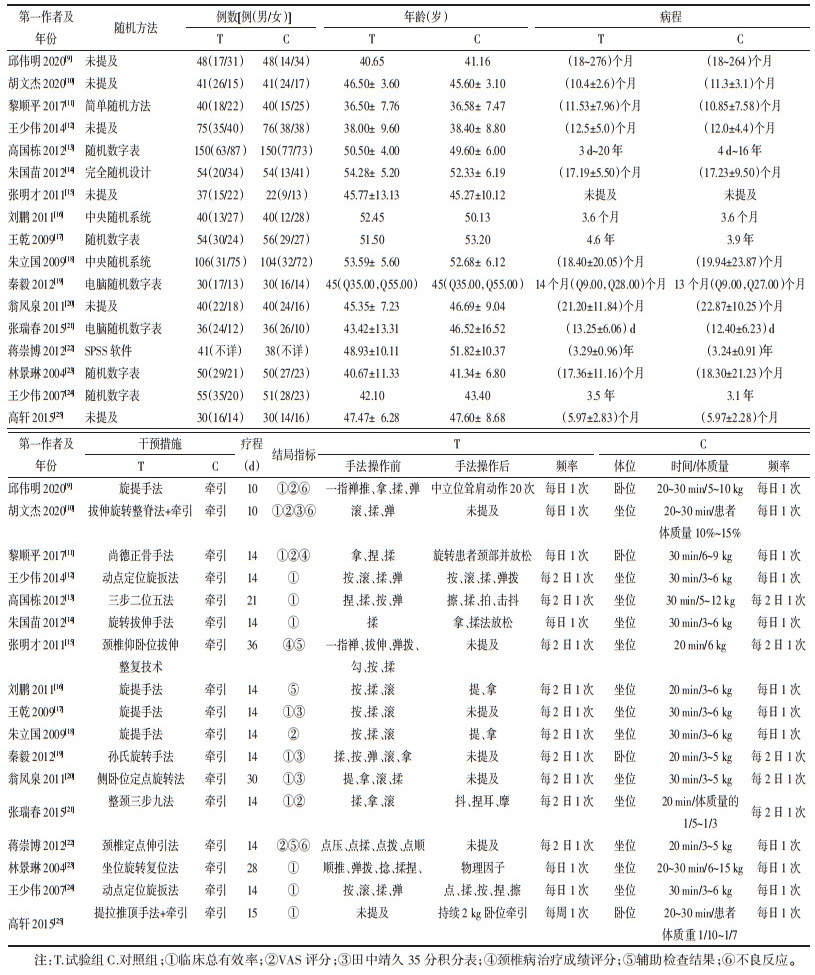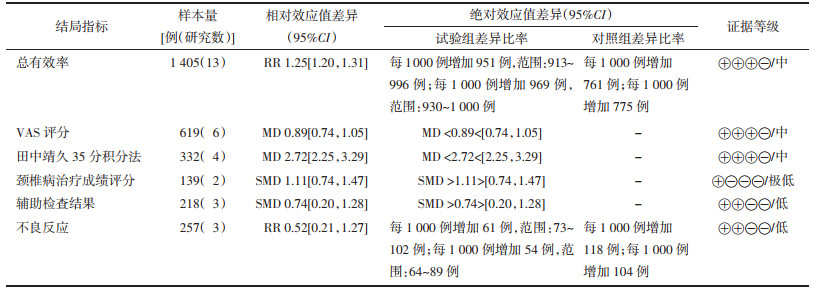文章信息
- 王槐旌, 符碧峰, 丁少杰, 等.
- WANG Huaijing, FU Bifeng, DING Shaojie, et al.
- 扳动类手法治疗神经根型颈椎病的有效性和安全性Meta分析及GRADE证据等级评价
- Meta analysis of efficacy and safety of pulling manipulation in the treatment of cervical spondylotic radiculopathy and evaluation of GRADE evidence level
- 天津中医药, 2023, 40(5): 622-632
- Tianjin Journal of Traditional Chinese Medicine, 2023, 40(5): 622-632
- http://dx.doi.org/10.11656/j.issn.1672-1519.2023.05.15
-
文章历史
- 收稿日期: 2023-02-23
2. 天津中医药大学第一附属医院骨伤科,国家中医药管理局区域中医骨伤科诊疗中心,天津 300381;
3. 天津市中医药研究院附属医院针灸一科,天津 300120;
4. 中国中医科学院望京医院脊柱二科,北京 100102
颈椎病是由颈椎间盘退变引起的一种临床综合征,神经根型颈椎病是最常见的颈椎病分型,发病率占60%[1]。目前公认的神经根型颈椎病发病机制的学说有:1)机械压迫学说[2]。2)动静力失衡。3)机体免疫及基因因素[3]。4)生物——化学因素[4]。
扳动类手法为治疗该疾病的主要手法,主要原理是颈椎沿垂直轴进行旋转,当旋转到阻力点(扳机点)时,用力做一个扳法使关节的活动增加3~5°,能听到关节弹响声,但不必强求[5]。该类手法需要较高的稳定性、准确性、灵活性和速度。颈椎旋转时,椎间盘会受到较大的剪切力[6],导致颈椎间盘纤维环断裂,髓核突出,若施术者在操作时用力不当,易造成意外。但扳动类手法因其疗效确切,若手法操作在安全范围内,可有立竿见影的效果。目前有许多临床试验已经证明了扳动类手法治疗神经根型颈椎病的有效性和安全性,但循证医学的证据水平不足,因此,本研究运用Meta分析的方法,评价扳动类手法治疗神经根型颈椎病的有效性和安全性,为临床实践提供借鉴。
1 资料及方法 1.1 纳入标准和排除标准 1.1.1 纳入标准1)研究对象:诊断为神经根型颈椎病的患者,诊断标准参考《中医病症诊断疗效标准》[7]或《第二届颈椎病专题座谈会纪要》[8]。2)试验组:扳动类手法及扳动类手法联合牵引。3)对照组:牵引。4)结局指标:临床总有效率(参照中医药管理局颁布的《中医病症诊断疗效标准》[7])、视觉模拟量表(VAS)评分、田中靖久35分积分法、颈椎病治疗成绩评分、辅助检查结果(包括影像学、化验及红外热成像等功能检查所得结果)、不良反应。5)研究类型:随机对照试验,有或无盲法。
1.1.2 排除标准1)重复文献及相似文献。2)非随机对照试验文献(综述、基础研究、病例报告、专家共识)。3)会议文献。4)多臂试验。5)试验组手法不是扳动类或联合其他非牵引的干预措施,对照组不是牵引。6)具有严重骨质疏松、脊柱损伤、脊柱先天畸形、椎管狭窄、严重内科疾病的患者为研究对象的文献。
1.2 文献检索 1.2.1 数据库中国知网(CNKI)、万方数据库(WangFang)、维普数据库(VIP)、中国生物医学文献数据库(SinoMed)等中文数据库及PubMed、Embase、The Cochrane Library等英文数据库,检索时间:建库至2021年12月。
1.2.2 检索词中文检索词:颈椎病、神经根型颈椎病、项痹、项痹病、颈肩痛、手法、整脊、扳、旋、旋提、提扳、随机、随机对照试验等。英文检索词:Cervical spondylosis,cervical spondylotic radiculopathy,paraplegia,cervical and shoulder pain,pulling,manipulative,manipulative therapy,twisting,rotary lifting,lifting,random,randomized controlled trial,RCT等。
1.3 文献筛选、数据管理及质量评价由2名经过培训的文献筛选员根据既定的纳入排除标准进行筛选,如果存在分歧,则邀请第3位研究人员参与讨论。合格文献的数据(第一作者、发表年份、试验组和对照组的样本量、性别、年龄等基线特征、病程、治疗方法、疗程、结局指标等)通过双人重复式资料提取到WPS Office Excel,必要时向作者询问原始数据,明确相关研究信息。按照“偏倚风险评估”工具中的项目:随机化、分配隐藏、受试者受盲、研究者受盲、结局评价者受盲、不完整偏倚、选择性偏倚、其他偏倚,对每篇纳入文献作出低风险(Low risk)、不清楚风险(Unclear risk)、高风险(High risk)评估,并绘制偏倚风险图。
1.4 统计学方法运用RevMan5.3将所提取的数据资料作异质性检验,I2 < 50%,异质性较低,选择固定效应模型;I2 > 50%,异质性适中,选用随机效应模型;I2 > 75%,说明异质性较高,要寻找异质性来源,若找不到异质性来源,放弃Meta分析,只作结果一般描述。二分类变量采用相对危险度(RR)及95%的可信区间(CI)评估;连续性变量采用加权均数差(WMD)或标准化均数差(SMD)及95%CI评估。规定检验水准α为0.05,P < 0.05则表明有统计学意义。若单项结局指标所包含的研究数量≥10,用漏斗图和Egger’s回归图判断和分析发表偏倚,漏斗图用RevMan5.3绘制,Egger’s回归图用Stata15进行绘制。
2 结果 2.1 检索流程共检索出5 874篇文献,经过严格的筛选和剔除,最终纳入17项研究[9-25]。具体检索流程根据PRISMA流程图绘制,见图 1。
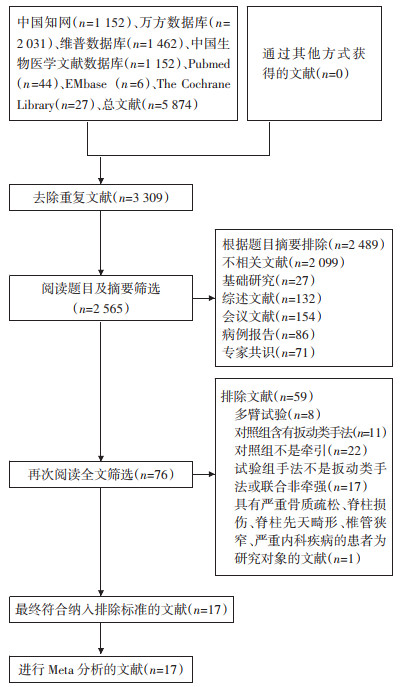
|
| 图 1 文献检索PRISMA流程图 Fig. 1 Flow chart of PRISMA for literature retrieval |
本研究共纳入1 833例患者,其中试验组927例,对照组906例,纳入研究均有明确的纳入排除标准。1篇文献[15]未描述患者病程信息,其余文献详细列举了试验组和对照组的基线数据(性别、年龄及病程等),并具有可比性(P > 0.05)。具体临床研究的特点。见表 1。
纳入的研究中,试验组为扳动类手法或扳动类手法联合牵引。2项研究运用扳动类手法联合牵引[10, 25],其余研究的试验组仅有扳动类手法干预。虽然试验组运用的扳动类手法有细微差别,但都可以概括为:先运用揉法、拿法、滚法将患者颈部肌肉放松,之后将患者的颈椎被动旋转至极限,用力做一个扳法使患者颈椎活动增加3~5°,并能听到关节弹响声,最后再用揉法、拿法、滚法等整理手法放松颈部肌肉,见表 1。
2.3 纳入研究质量评价使用改良Cochrane偏倚风险评估工具[26]对纳入的文献进行质量评估,见图 2。随机方法:11项研究详细描述了随机方法,如随机数字表、软件随机等[11, 13-14, 16-19, 21-24],评价为低风险;6项研究未详细描述随机方法[9-10, 12, 15, 20, 25],评价为不清楚。受试者及研究者盲法:1项研究对受试者使用盲法[14],评价为低风险;其余研究未提及,因为结局指标具有主观性,其测量与评价会受到影响,故对患者和研究者盲法评价为高风险。结局评价者盲法:均未报道,评价为不清楚。分配隐藏:1项研究使用信封法进行分配隐藏[11],评价为低风险,其余均未报道。数据完整性:2项研究存在脱落患者[18, 22],并解释了原因,其余未报道脱落及退出情况,评价为低风险;选择性报告:所有试验未报道,评价为不清楚;其他偏倚:均未提及,评价为不清楚。文献质量评估结果见图 2。
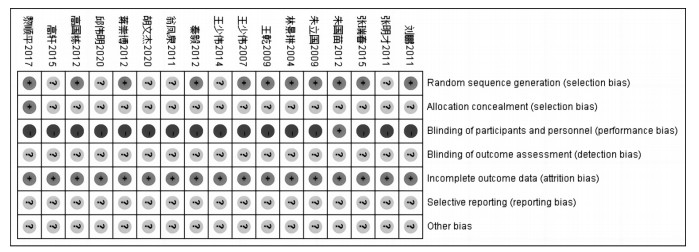
|
| 图 2 纳入文献质量评价 Fig. 2 Included literature quality evaluation |
共13项试验[9-14, 17, 19-2, 25],异质性检验结果:I2=41%,P=0.06,异质性低,采用固定效应模型分析。根据试验组干预措施的不同分为2个亚组,结果:试验组的临床总有效率与对照组比较有统计学意义[RR=1.25,95%CI(1.20,1.31),P < 0.000 01]。亚组分析示:单独运用手法效果更佳。见图 3。
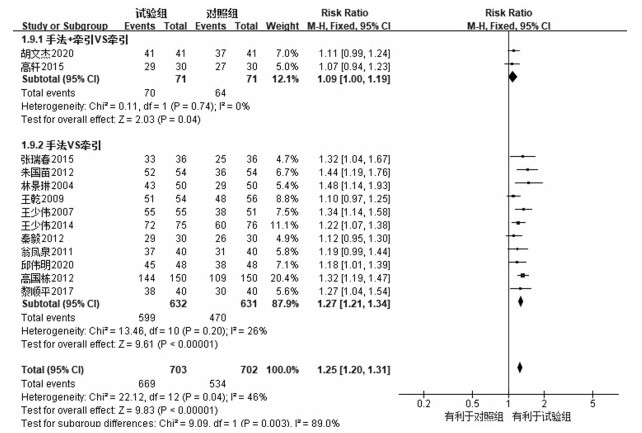
|
| 图 3 纳入文献临床总有效率Meta分析 Fig. 3 Meta analysis of total clinical effective rate of included literature |
共6项试验[9-11, 18, 22-23],异质性检验结果:I2=89%,P<0.000 01,异质性高,运用随机效应模型分析。根据试验组干预措施的不同分为2个亚组,结果:试验组VAS评分低于对照组,差异有统计学意义[WMD=-1.38,95%CI(-1.90,-0.86),P<0.000 01]。亚组分析示:单独运用扳动类手法效果更佳。见图 4。
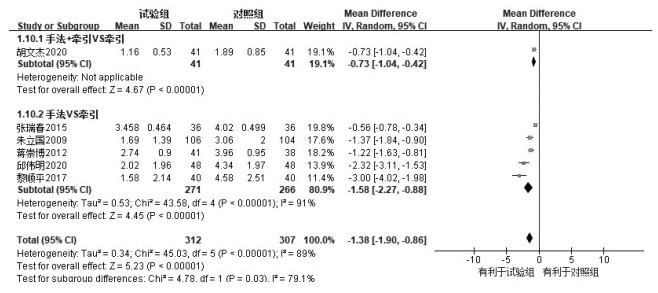
|
| 图 4 纳入文献VAS评分Meta分析 Fig. 4 Meta analysis of VAS score of included literature |
共4项试验[10, 17, 19-20],异质性检验结果:I2=0%,P=0.47。根据试验组干预措施的不同分为2个亚组,结果:试验组症状体征积分低于对照组,差异具有统计学意义[WMD=-2.72,95%CI(-3.29,-2.15),P<0.000 01]。亚组分析示:尚未发现扳动类手法联合颈椎牵引能更好地降低患者田中靖久35分积分法得分。见图 5。
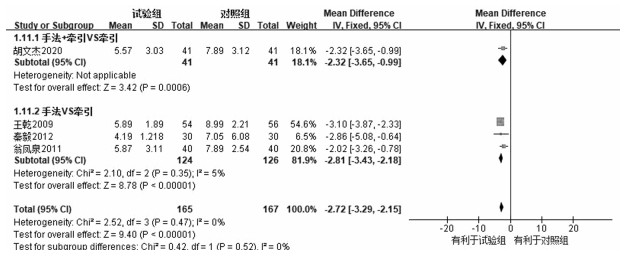
|
| 图 5 纳入文献田中靖久35分积分法Meta分析 Fig. 5 Meta analysis of Yasuhisa Tanaka's 35-point integral method included in the literature |
共2项试验[11, 15],异质性检验结果:I2=50%,P=0.16,异质性中。结果:试验组的颈椎病治疗成绩评分与对照组比较,差异具有统计学意义[SMD=1.09,95%CI(0.58,1.61),P<0.000 1]。见图 6。

|
| 图 6 纳入文献颈椎病治疗成绩评分改善率Meta分析 Fig. 6 Meta analysis of improvement rate of cervical spondylosis treatment score included in the literature |
共3项试验[15-16, 22],I2=73%,P=0.03,有高度异质性(见图 7),故对其一般描述:查阅该结局指标的纳入文献,发现试验组的颈椎曲度、椎间孔矢状径比率双上肢红外热成像加黑温差值与对照组比较均有统计学差异。

|
| 图 7 纳入文献症辅助检查结果Meta分析 Fig. 7 Meta analysis of auxiliary examination results of included literature |
3项研究报告了不良反应[9-10, 22],异质性检测结果:I2=27%,P=0.25,异质性低,用固定效应模型。根据试验组干预措施的不同分为2个亚组,结果:[RR=0.48,95%CI(0.21,1.09),P=0.08],差异无统计学意义。亚组分析示:单独运用手法组与牵引组相比差异具有统计学意义,手法联合牵引组与牵引组比较差异没有统计学意义。见图 8。
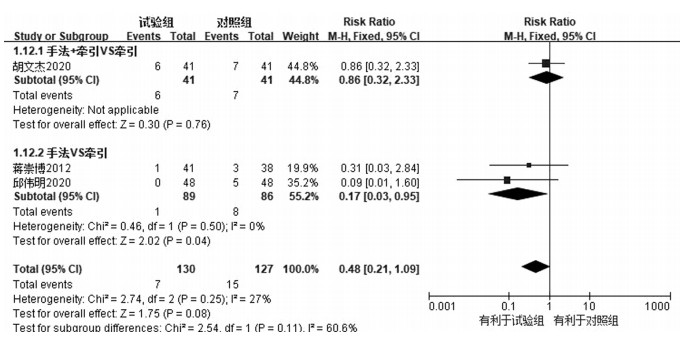
|
| 图 8 纳入文献不良反应Meta分析 Fig. 8 Meta analysis of adverse reactions in the included literature |
对总有效率制作漏斗图及Egger’s回归图,对总有效率进行Egger’s检验分析发表偏倚。总有效率的漏斗图显示基本对称,并结合Egger’s检验的结果(t=0.47,P=0.646),提示发表偏倚没有统计学意义,见图 9。

|
| 图 9 总有效率漏斗图(A)和Egger’s回归图(B) Fig. 9 Funnel plot (A) and Egger's funnel plot (B) for total effective rate |
为了寻找VAS评分、颈椎病治疗成绩评分改善率及辅助检查结果的异质性来源,对VAS评分、颈椎病治疗成绩评分及辅助检查结果进行亚组分析。对VAS评分以牵引体位、牵引质量、干预方式进行分组,见表 2和图 10-12,可以发现,引起本研究异质性高的因子是牵引体位、牵引质量。从报道颈椎病治疗成绩评分的相关文献发现,引起异质性高的因子为治疗频率、牵引体位、牵引时间。从报告辅助检查结果的相关文献发现引起异质性高的原因:2项试验[15-16]报告患者影像学改变,1项试验[22]报告患者上肢红外热成像温差改变。
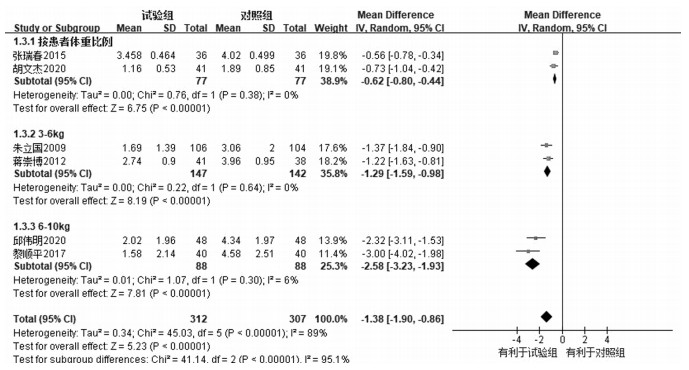
|
| 图 10 VAS评分亚组分析森林图——按牵引重量分组 Fig. 10 VAS scoring subgroup analysis forest map - grouping by traction |
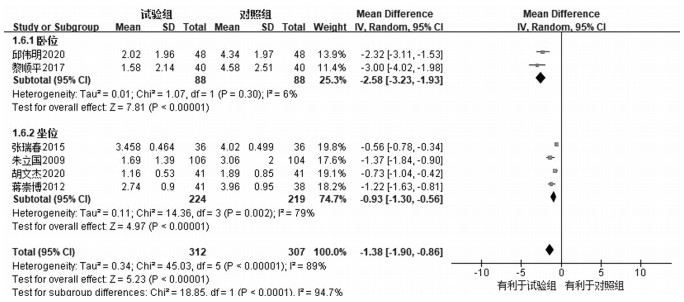
|
| 图 11 VAS评分亚组分析森林图——按牵引体位分组 Fig. 11 VAS score subgroup analysis forest map - grouping by traction position |
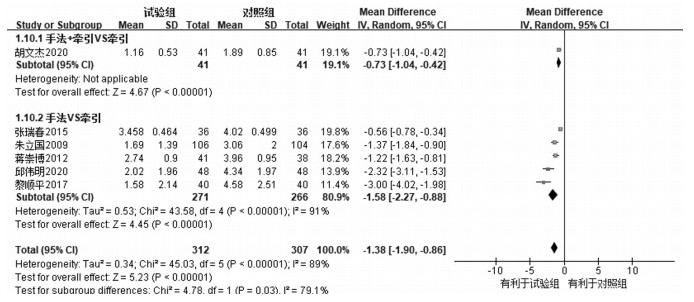
|
| 图 12 VAS评分亚组分析森林图——按干预方式分组 Fig. 12 VAS score subgroup analysis forest map - grouping by intervention |
改变合并量的效应模型及逐一排除研究,结局指标的合并效应量变化不明显,结果稳定可靠,见表 3。
总有效率、VAS评分、田中靖久35分积分法为中等质量证据,不良反应为低质量证据,颈椎曲度、颈椎病治疗成绩评分为极低质量证据,见表 4。所有研究都直接报告了结局指标。降低原因:1)1项研究提及运用盲法,1项研究提及分配隐藏。2)VAS评分、颈椎病治疗成绩评分及辅助检查结果存在一定异质性。3)因为无法获得研究计划书,故选择性报告无法判断。
扳动类手法能调整颈椎周围异常应力分布,增强和稳定颈椎,扩大椎间孔面积,恢复钩椎与关节之间的正常位置关系。主要运用上肢力量与技巧,巧妙运用杠杆原理施用手法,矫正颈椎小关节紊乱,恢复解剖序列。扳动出现的“咯嗒”声,说明扳动力已作用于脊柱关节并使其运动[27]。
研究纳入了17篇扳动类手法的随机对照试验,试验组采用扳动类手法及扳动类手法联合牵引干预,对照组仅采用牵引干预。结果:手法组及手法联合牵引的临床总有效率、VAS评分、田中靖久35分积分法、辅助检查结果均优于牵引组;而手法组的不良反应与牵引组比较差异有统计学意义,手法联合牵引组的不良反应与牵引组比较差异没有统计学意义,可能该效应指标纳入试验较少,不良反应报导不全所致。
研究运用GRADE等级评价扳动类手法治疗神经根型颈椎病总有效率、VAS评分、田中靖久35分积分法、颈椎病治疗成绩评分、辅助检查结果、不良反应6个结局指标。总有效率、VAS评分、田中靖久35分积分法的结局指标等级是中,辅助检查结果、不良反应的证据等级是低,颈椎病治疗成绩评分改善率的等级是极低。症状体征积分、颈椎病治疗成绩评分和辅助检查结果的评分较低的主要原因是各纳入研究之间的异质性过大导致。纳入研究缺乏评价患者生活质量的结局指标,故今后研究者再选用结局指标评价患者疗效时,可考虑多选用评估患者生活水平、情感职能、社会关系的结局指标。
与以往的相似研究[28-30]相比,研究仅纳入了试验组为扳动类手法及扳动类手法联合了牵引治疗,对照组仅有牵引治疗。对照组对牵引体位、牵引质量作了亚组分析,并找到了异质性来源。研究运用了GRADE标准评价各效应指标的证据质量,可为临床决策提供一定借鉴意义。
研究的局限性:1)文章只纳入中文文献。2)虽然对患者做手法、做牵引的过程中施盲于患者不实际,但对结局评价者施盲能提高结局的准确度。
综上所述,用扳动类手法治疗神经根型颈椎病,能提高患者的疗效,减轻患者疼痛症状,而安全性与牵引治疗相比无统计学差异,亚组分析发现单用手法能减轻患者症状,增加有效率,减少不良反应的发生,牵引的体位、质量对患者的疗效有影响。但由于现有的研究对盲法的使用较少,对分配隐藏、结果数据完整度、选择报告及其他偏倚的叙述较少,故将来应开展大样本,多中心,高质量的随机对照研究,进一步证明扳动类手法治疗神经根型颈椎病有效性和安全性结论的准确性。
| [1] |
吴在德, 吴肇汉. 外科学[M]. 7版. 北京: 人民卫生出版社, 2008: 855. WU Z D, WU Z H. Surgery[M]. 7th edition. Beijing: People's Medical Publishing House, 2008: 855. |
| [2] |
吴子龙, 杨利学. 神经根型颈椎病引起根性痛的研究进展[J]. 中西医结合研究, 2013, 5(5): 269-271. WU Z L, YANG L X. Research progress of radicular pain caused by cervical spondylotic radiculopathy[J]. Research of Integrated Traditional Chinese and Western Medicine, 2013, 5(5): 269-271. |
| [3] |
NIU Y Y, ZENG X X, QIN G C, et al. Downregulation of metabotropic glutamate receptor 5 alleviates central sensitization by activating autophagy via inhibiting mTOR pathway in a rat model of chronic migraine[J]. Neuroscience Letters, 2021, 743: 135552. DOI:10.1016/j.neulet.2020.135552 |
| [4] |
王小云, 章路军, 叶羽翀. 神经根型颈椎病神经根性疼痛与炎性因子相关性研究[J]. 福建医药杂志, 2019, 41(1): 13-15. WANG X Y, ZHANG L J, YE Y C. Correlational research between inflammatory factors and nerve root pain of patients with cervical spondylotic radiculopathy[J]. Fujian Medical Journal, 2019, 41(1): 13-15. |
| [5] |
王新军. 论颈椎旋转扳法的机理及注意事项[J]. 上海中医药杂志, 2001, 35(11): 33-34. WANG X J. Mechanism and precautions of cervical rotating manipulation[J]. Shanghai Journal of Traditional Chinese Medicine, 2001, 35(11): 33-34. |
| [6] |
王国才. 推拿手法学[M]. 北京: 中国中医药出版社, 2003: 220. WANG G C. Massage manipulation[M]. Beijing: China Press of Traditional Chinese Medicine, 2003: 220. |
| [7] |
国家中医药管理局. 中医病症诊断疗效标准[M]. 南京: 南京大学出版社, 1994: 63-65. National Administration of Traditional Chinese Medicine. Standards for diagnosis and curative effect of Chinese medical symptom[M]. Nanjing: Nanjing University Press, 1994: 63-65. |
| [8] |
孙宇, 李贵存. 第二届颈椎病专题座谈会纪要[J]. 解放军医学杂志, 1994, 19(2): 156-158. SUN Y, LI G C. Summary of the second symposium on cervical spondylosis[J]. Medical Journal of Chinese PLA, 1994, 19(2): 156-158. |
| [9] |
邱伟明. 不同方向旋提手法治疗神经根型颈椎病的疗效观察[J]. 云南中医中药杂志, 2020, 41(7): 69-71. QIU W M. Clinical observation on the treatment of cervical spondylotic radiculopathy with different directions of rotation and lifting manipulation[J]. Yunnan Journal of Traditional Chinese Medicine and Materia Medica, 2020, 41(7): 69-71. |
| [10] |
胡文杰, 王涛, 孙伟, 等. 拔伸旋转整脊法配合微波治疗神经根型颈椎病临床观察[J]. 河北中医, 2020, 42(10): 1564-1567. HU W J, WANG T, SUN W, et al. Clinical observation on the treatment of cervical spondylotic radiculopathy by stretching and rotating chiropractic combined with microwave[J]. Hebei Journal of Traditional Chinese Medicine, 2020, 42(10): 1564-1567. |
| [11] |
黎顺平, 唐上德, 王云娜, 等. 尚德正骨手法治疗中青年神经根型颈椎病40例[J]. 山东中医杂志, 2017, 36(10): 876-878. LI S P, TANG S D, WANG Y N, et al. Shangde bone-setting manipulation treatment of cervical spondylotic radiculopathy for young and middle-aged[J]. Shandong Journal of Traditional Chinese Medicine, 2017, 36(10): 876-878. |
| [12] |
王少伟, 郑志辉. 动点定位旋扳手法配合葛根解肌汤治疗神经根型颈椎病疗效观察[J]. 新中医, 2014, 46(7): 95-96. WANG S W, ZHENG Z H. Clinical observation on the treatment of cervical spondylotic radiculopathy by moving point positioning and rotating wrench combined with Gegen Jieji Decoction[J]. Journal of New Chinese Medicine, 2014, 46(7): 95-96. |
| [13] |
高国栋, 张晓刚, 宋敏, 等. "三步二位五法"治疗神经根型颈椎病150例临床观察[J]. 中国中医骨伤科杂志, 2012, 20(4): 18-20. GAO G D, ZHANG X G, SONG M, et al. Clinical observation of three-step and two of five-therapy in the treatment of nerve root type cervical spondylosis[J]. Chinese Journal of Traditional Medical Traumatology & Orthopedics, 2012, 20(4): 18-20. |
| [14] |
朱国苗. 旋转拔伸手法治疗神经根型颈椎病的临床经济学研究[J]. 时珍国医国药, 2012, 23(9): 2338-2339. ZHU G M. Clinical and economic study on the treatment of cervical spondylotic radiculopathy by rotating pulling and stretching[J]. Lishizhen Medicine and Materia Medica Research, 2012, 23(9): 2338-2339. |
| [15] |
张明才, 石印玉, 陈东煜, 等. 矫正关节突关节"骨错缝"手法治疗神经根型颈椎病的有效性研究[J]. 上海中医药杂志, 2011, 45(12): 42-45. ZHANG M C, SHI Y Y, CHEN D Y, et al. Effectiveness study on correction procedure for zygapophyseal joint in treating cervical spondylotic radiculopathy[J]. Shanghai Journal of Traditional Chinese Medicine, 2011, 45(12): 42-45. |
| [16] |
刘鹏, 李远栋, 张君涛, 等. 旋提手法对神经根型颈椎病曲度改变的疗效分析[J]. 天津中医药, 2011, 28(4): 298-300. LIU P, LI Y D, ZHANG J T, et al. Clinical effect of rotating and lifting manipulation in improving cervical curvature of cervical spondylotic radiculopathy[J]. Tianjin Journal of Traditional Chinese Medicine, 2011, 28(4): 298-300. |
| [17] |
王乾, 朱立国, 高景华, 等. 旋提手法治疗神经根型颈椎病的疗效观察[J]. 中医正骨, 2009, 21(6): 9-11. WANG Q, ZHU L G, GAO J H, et al. Clinical observation on rotation-traction manipulation for treatment of the cervicalspondylotic radiculopathy[J]. The Journal of Traditional Chinese Orthopedics and Traumatology, 2009, 21(6): 9-11. |
| [18] |
朱立国, 于杰, 高景华, 等. 神经根型颈椎病患者的疼痛和麻木观测[J]. 中国中医骨伤科杂志, 2009, 17(4): 1-3. ZHU L G, YU J, GAO J H, et al. The measurement of pain and numbness in patients with cervical spondylotic radiculopathy[J]. Chinese Journal of Traditional Medical Traumatology & Orthopedics, 2009, 17(4): 1-3. |
| [19] |
秦毅, 李振宇, 鲁尧, 等. 孙氏旋转手法治疗神经根型颈椎病临床研究[J]. 中国中医骨伤科杂志, 2012, 20(7): 3-5. QIN Y, LI Z Y, LU Y, et al. Randomized controlled clinical study of the clinical efficacy of the Sun manipulation of rotating treatment to cervical spondylotic radiculopathy[J]. Chinese Journal of Traditional Medical Traumatology & Orthopedics, 2012, 20(7): 3-5. |
| [20] |
翁凤泉, 李宇明, 翁志辉, 等. 侧卧位定点旋转手法治疗神经根型颈椎病的临床研究[J]. 新中医, 2011, 43(4): 50-52. WENG F Q, LI Y M, WENG Z H, et al. Clinical study on the treatment of cervical spondylotic radiculopathy with fixed-point rotation manipulation in lateral position[J]. Journal of New Chinese Medicine, 2011, 43(4): 50-52. |
| [21] |
张瑞春, 马鑫文, 沈明球. "整颈三步九法"治疗神经根型颈椎病随机对照临床试验研究[J]. 辽宁中医药大学学报, 2015, 17(2): 81-83. ZHANG R C, MA X W, SHEN M Q. Cervical three steps nine manuevers in treatment of cervicalspondylosis radiculopathy by randomized controlled clinical trial[J]. Journal of Liaoning University of Traditional Chinese Medicine, 2015, 17(2): 81-83. |
| [22] |
蒋崇博, 王军, 郑志新, 等. 颈椎定点引伸手法治疗神经根型颈椎病的随机对照研究[J]. 中西医结合学报, 2012, 10(1): 54-58. JIANG C B, WANG J, ZHENG Z X, et al. Efficacy of cervical fixed-point traction manipulation for cervical spondylotic radiculopathy: a randomized controlled trial[J]. Journal of Chinese Integrative Medicine, 2012, 10(1): 54-58. |
| [23] |
林景琳, 杨锦玲. 旋转复位与牵引治疗神经根型颈椎病的随机对照疗效分析[J]. 中国临床康复, 2004, 8(17): 3234-3235. LIN J L, YANG J L. Randomized controlled analysis of rotatory reduction and physical therapy in treatment of cervicalspondylotic radiculopathy[J]. Chinese Journal of Clinical Rehabilitation, 2004, 8(17): 3234-3235. |
| [24] |
王少伟, 李伟居, 黄桂忠. 动点定位旋扳手法治疗神经根型颈椎病的临床观察[J]. 中国中医骨伤科杂志, 2007, 15(4): 47-49. WANG S W, LI W J, HUANG G Z. Clinical observation on the treatment of cervical spondylotic radiculopathy by rotating wrench with moving point positioning[J]. Chinese Journal of Traditional Medical Traumatology & Orthopedics, 2007, 15(4): 47-49. |
| [25] |
高轩, 刘佳, 李道通, 等. 优值牵引法结合提拉推顶手法治疗神经根型颈椎病临床观察[J]. 风湿病与关节炎, 2015, 4(3): 20-22. GAO X, LIU J, LI D T, et al. Clinical observation on the treatment of cervical spondylotic radiculopathy with merit traction method combined with pulling-pushing manipulation[J]. Rheumatism and Arthritis, 2015, 4(3): 20-22. |
| [26] |
ZHAO J G, ZENG X T, WANG J, et al. Association between calcium or vitamin D supplementation and fracture incidence in community-dwelling older adults: a systematic review and Meta-analysis[J]. JAMA, 2017, 318(24): 2466-2482. |
| [27] |
李义凯, 赵卫东, 钟世镇. 两种颈部旋转手法"咔嗒"声的比较研究[J]. 中医正骨, 1998, 10(6): 9-10. LI Y K, ZHAO W D, ZHONG S Z. A comparative study on the crackings during two rotatory manipulations of the neck[J]. The Journal of Traditional Chinese Orthopedics and Traumatology, 1998, 10(6): 9-10. |
| [28] |
李哲, 田好超, 黄委委, 等. 手法治疗神经根型颈椎病疗效的系统评价[J]. 中国中医急症, 2019, 28(10): 1755-1761. LI Z, TIAN H C, HUANG W W, et al. Manipulation treatment on nerve-root-type cervical spondylosis systematic review of clinical[J]. Journal of Emergency in Traditional Chinese Medicine, 2019, 28(10): 1755-1761. |
| [29] |
黄俊能, 何育风. 手法与牵引对椎动脉型颈椎病疗效的Meta分析[J]. 湖南中医杂志, 2018, 34(8): 160-163. HUANG J N, HE Y F. Meta-analysis of therapeutic effect of manipulation and traction on cervical spondylosis of vertebral artery type[J]. Hunan Journal of Traditional Chinese Medicine, 2018, 34(8): 160-163. |
| [30] |
王艳国, 郭秀琴, 张琪, 等. 手法治疗神经根型颈椎病的系统评价[J]. 中华中医药杂志, 2013, 28(2): 499-503. WANG Y G, GUO X Q, ZHANG Q, et al. System review on manipulative therapy in the treatment of cervical spondylotic radiculopathy[J]. China Journal of Traditional Chinese Medicine and Pharmacy, 2013, 28(2): 499-503. |
2. Department of Orthopedics, First Teaching Hospital of Tianjin University of Traditional Chinese Medicine, National Administration of Traditional Chinese Medicine Regional Orthopedics and Traumatology Diagnosis and Treatment Center, Tianjin 300381, China;
3. First Department of Acupuncture and Moxibustion, Tianjin Academy of Traditional Chinese Medicine Affiliated Hospital, Tianjin 300120, China;
4. Second Spine Department, Wangjing Hospital of China Academy of Chinese Medical Science, Beijing 100102, China
 2023, Vol. 40
2023, Vol. 40





